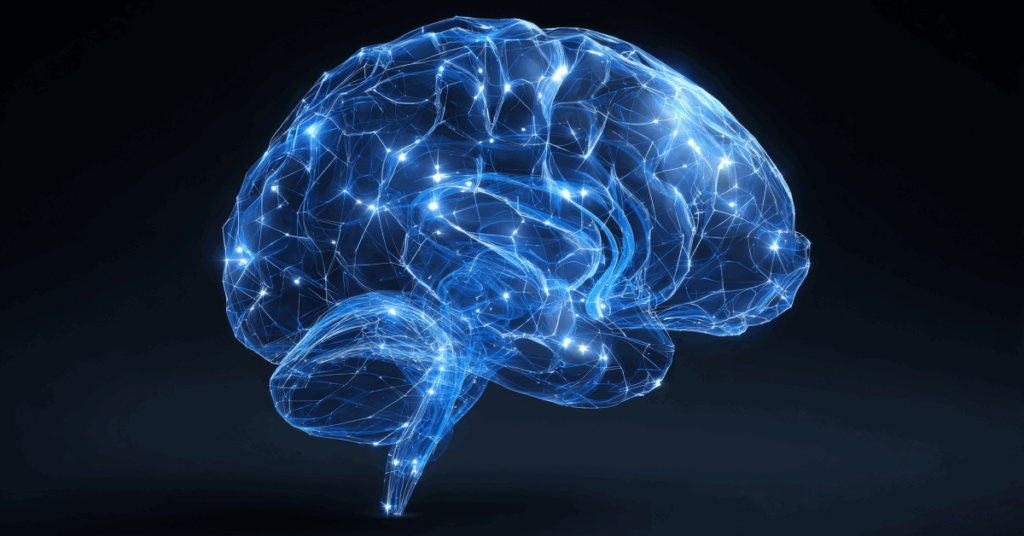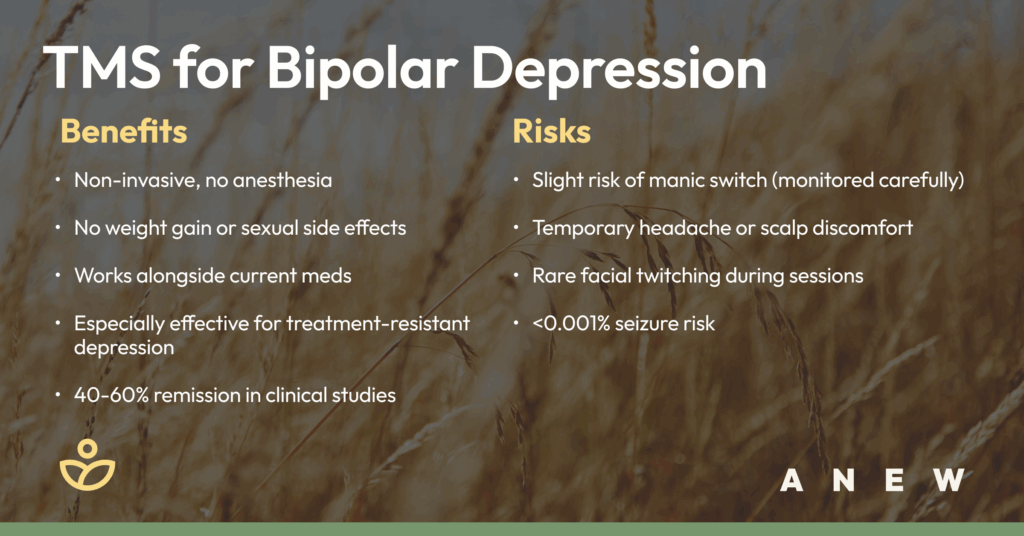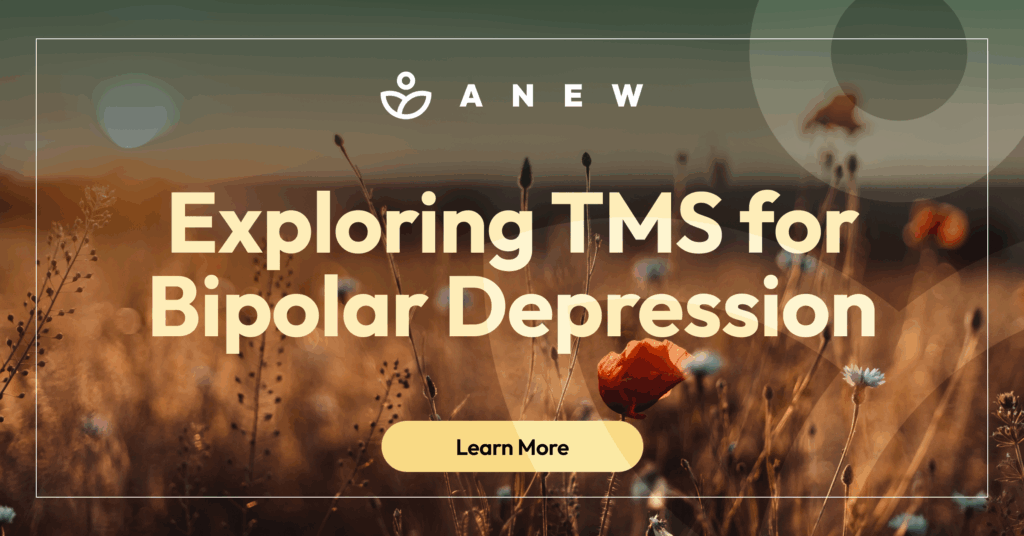Transcranial magnetic stimulation bipolar treatment is being explored as a promising option for people experiencing the depressive phase of bipolar disorder, especially when standard treatments haven’t helped. This non-invasive therapy uses magnetic pulses to stimulate underactive brain regions involved in mood regulation.
Key Facts About TMS for Bipolar Depression:
- FDA Status: Breakthrough device designation in 2020
- Effectiveness: 40-60% remission rates in clinical studies
- Safety: Fewer side effects than medications
- Course: 4-6 weeks of weekday sessions
- Length: 3 to 37 minutes per session
Bipolar disorder often brings more time in depressive lows than in manic highs. Antidepressants may not work well for these episodes and sometimes increase the risk of mania, making alternative treatments worth exploring.
TMS works differently than medication. Instead of adjusting brain chemistry, it delivers magnetic pulses to the left dorsolateral prefrontal cortex, a brain area tied to mood regulation. Treatment is straightforward: you sit comfortably while a clinician places a coil on your scalp. Most people remain awake and feel only a light tapping sensation.
A 2020 study of 44 people with bipolar depression found that 77% had significant symptom improvement. Among those who completed 25 sessions, 41% reached full remission.
Important Note:TMS is not suitable for everyone with bipolar disorder. It carries a small risk of triggering manic symptoms, especially in people not stabilized on medication. At Anew Therapy, we consider TMS only after thorough evaluation and deemed appropriate. Patients are also closely monitored throughout treatment.
The Role of Transcranial Magnetic Stimulation (TMS) for Bipolar Disorder
When we think about breakthrough treatments for bipolar disorder, transcranial magnetic stimulation bipolar therapy stands out as one of the most promising developments in recent years. At Anew Therapy in Utah, we’re always excited to explore innovative approaches that can help our patients find relief from their symptoms.
Efficacy and FDA Status of Transcranial Magnetic Stimulation for Bipolar Depression
The mental health field took notice in 2020 when the FDA granted TMS breakthrough device designation specifically for bipolar depression. While this isn’t full approval yet, it’s a significant milestone that fast-tracks the review process and recognizes TMS as addressing a serious unmet medical need.
Currently, TMS is used off-label for bipolar depression, but emerging research results are encouraging. Clinical studies show remission rates between 40-60% for people with bipolar depression who receive TMS treatment. These outcomes are measured using standardized tools like the Montgomery-Asberg Depression Rating Scale (MADRS), which helps clinicians track how well symptoms improve over time.
What makes these results particularly meaningful is that many participants in these studies had treatment-resistant depression – meaning they hadn’t found relief with traditional medications. The promising research continues to build, giving us more confidence in TMS as a viable option for bipolar patients struggling with depressive episodes.
The TMS Treatment Process: What to Expect

If you’re considering transcranial magnetic stimulation bipolar therapy, you’ll be happy to know the process is surprisingly straightforward and comfortable. The entire treatment happens on an outpatient basis, so there’s no need for hospital stays or complicated scheduling.
Most people come in for daily sessions, typically five days a week, over a 4-6 week treatment course. Modern TMS treatment can be very flexible – session duration can range from just 3 minutes with newer approaches like theta-burst stimulation to about 37 minutes with traditional methods.
During each session, you’ll sit comfortably in a treatment chair while a trained clinician positions a magnetic coil against your scalp. No anesthesia is required, patients stay awake and alert the entire time. You might hear some clicking sounds and feel gentle tapping sensations, but most people find it quite tolerable. Many even bring a book or listen to music during longer sessions.
Benefits and Risks of Transcranial Magnetic Stimulation for Bipolar Patients
When weighing treatment options for bipolar disorder, it’s important to understand both the advantages and potential concerns with transcranial magnetic stimulation bipolar therapy.
The benefits are compelling. TMS is non-invasive, avoiding the need for surgery or anesthesia that comes with treatments like ECT. You’ll experience minimal systemic side effects compared to medications – no weight gain, sexual dysfunction, or stomach upset that often accompanies oral treatments. For people managing complex medication regimens, TMS avoids medication interactions entirely since it works through direct brain stimulation rather than chemical pathways. Perhaps most importantly, TMS proves effective for treatment-resistant cases where traditional antidepressants haven’t provided relief.
The risks are generally mild but worth discussing. Mild headache and scalp discomfort are the most common side effects, usually temporary and improving after the first few sessions. Some people experience facial twitching during treatment, which stops immediately when the magnetic pulses end. There’s a rare risk of seizure – extremely low at about 0.001% of treatments – which clinics minimize through careful screening.For people with bipolar disorder, there is a known risk that TMS could trigger a manic episode. This risk tends to be lower when the person is also taking a mood stabilizer, but it’s still important to monitor closely throughout the course of treatment.

How TMS Integrates with Other Bipolar Treatments
At Anew Therapy, we believe the most effective mental health care combines multiple approaches custom to each person’s unique needs. Transcranial magnetic stimulation bipolar therapy works best when integrated thoughtfully with existing treatments.
Most people with bipolar disorder continue their medication regimens, particularly mood stabilizers like lithium or lamotrigine, while receiving TMS. Psychotherapy remains crucial for developing coping strategies and long-term management skills. TMS serves as a powerful adjunct to these established treatments rather than replacing them entirely.
A Promising Horizon for Bipolar Depression Treatment
The landscape of mental health treatment is evolving, and transcranial magnetic stimulation bipolar therapy is at the forefront of this change, offering hope for treatment-resistant bipolar depression. With remission rates of 40-60% in clinical studies, TMS provides a safe, non-invasive option that works alongside existing treatment plans without the systemic side effects of medication.
At Anew Therapy Utah, we are passionate about exploring advanced options for treatment-resistant conditions. We understand the challenges of living with bipolar disorder and are committed to providing holistic, individualized care. When traditional approaches fall short, innovative treatments like TMS can be life-changing.
The road ahead for TMS is bright, with larger clinical trials underway to refine protocols and best practices. As our understanding of brain networks deepens, treatments will become more precise. If you’ve felt like you’ve exhausted your options, the field is constantly advancing. The breakthrough you need may be available today.
We encourage you to explore what’s possible.Give us a call at (801) 980-2690 or schedule a free consultation to find how we can support you in finding the relief and hope you deserve.

Searching for the best TMS clinic in Utah? Anew Therapy offers expert care and proven results. Schedule your free intake appointment today.

